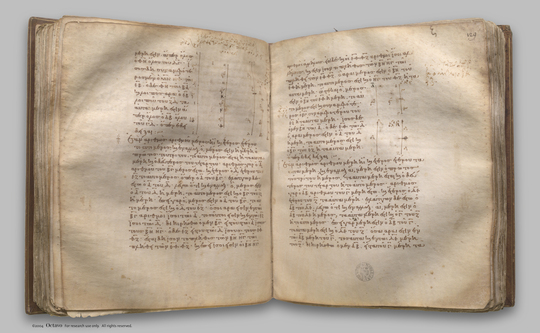index prev next | digilib folio 133

If a number be a part of a number, and another be the same part of another, alternately also, whatever part or parts the first is of the third, the same part, or the same parts, will the second also be of the fourth.
| Ἐὰν ἀριθμὸς ἀριθμοῦ μέρος ᾖ, καὶ ἕτερος ἑτέρου τὸ αὐτὸ μέρος ᾖ, καὶ ἐναλλάξ, ὃ μέρος ἐστὶν ἢ μέρη ὁ πρῶτος τοῦ τρίτου, τὸ αὐτὸ μέρος ἔσται ἢ τὰ αὐτὰ μέρη καὶ ὁ δεύτερος τοῦ τετάρτου. Ἀριθμὸς γὰρ ὁ Α ἀριθμοῦ τοῦ ΒΓ μέρος ἔστω, καὶ ἕτερος ὁ Δ ἑτέρου τοῦ ΕΖ τὸ αὐτὸ μέρος, ὅπερ ὁ Α τοῦ ΒΓ: λέγω, ὅτι καὶ ἐναλλάξ, ὃ μέρος ἐστὶν ὁ Α τοῦ Δ ἢ μέρη, τὸ αὐτὸ μέρος ἐστὶ καὶ ὁ ΒΓ τοῦ ΕΖ ἢ μέρη. Ἐπεὶ γὰρ ὃ μέρος ἐστὶν ὁ Α τοῦ ΒΓ, τὸ αὐτὸ μέρος ἐστὶ καὶ ὁ Δ τοῦ ΕΖ, ὅσοι ἄρα εἰσὶν ἐν τῷ ΒΓ ἀριθμοὶ ἴσοι τῷ Α, τοσοῦτοί εἰσι καὶ ἐν τῷ ΕΖ ἴσοι τῷ Δ. διῃρήσθω ὁ μὲν ΒΓ εἰς τοὺς τῷ Α ἴσους τοὺς ΒΗ, ΗΓ, ὁ δὲ ΕΖ εἰς τοὺς τῷ Δ ἴσους τοὺς ΕΘ, ΘΖ: ἔσται δὴ ἴσον τὸ πλῆθος τῶν ΒΗ, ΗΓ τῷ πλήθει τῶν ΕΘ, ΘΖ. Καὶ ἐπεὶ ἴσοι εἰσὶν οἱ ΒΗ, ΗΓ ἀριθμοὶ ἀλλήλοις, εἰσὶ δὲ καὶ οἱ ΕΘ, ΘΖ ἀριθμοὶ ἴσοι ἀλλήλοις, καί ἐστιν ἴσον τὸ πλῆθος τῶν ΒΗ, ΗΓ τῷ πλήθει τῶν ΕΘ, ΘΖ, ὃ ἄρα μέρος ἐστὶν ὁ ΒΗ τοῦ ΕΘ ἢ μέρη, τὸ αὐτὸ μέρος ἐστὶ καὶ ὁ ΗΓ τοῦ ΘΖ ἢ τὰ αὐτὰ μέρη: ὥστε καὶ ὃ μέρος ἐστὶν ὁ ΒΗ τοῦ ΕΘ ἢ μέρη, τὸ αὐτὸ μέρος ἐστὶ καὶ συναμφότερος ὁ ΒΓ συναμφοτέρου τοῦ ΕΖ ἢ τὰ αὐτὰ μέρη. ἴσος δὲ ὁ μὲν ΒΗ τῷ Α, ὁ δὲ ΕΘ τῷ Δ: ὃ ἄρα μέρος ἐστὶν ὁ Α τοῦ Δ ἢ μέρη, τὸ αὐτὸ μέρος ἐστὶ καὶ ὁ ΒΓ τοῦ ΕΖ ἢ τὰ αὐτὰ μέρη: ὅπερ ἔδει δεῖξαι. | If a number be a part of a number, and another be the same part of another, alternately also, whatever part or parts the first is of the third, the same part, or the same parts, will the second also be of the fourth. For let the number A be a part of the number BC, and another, D, the same part of another, EF, that A is of BC; I say that, alternately also, whatever part or parts A is of D, the same part or parts is BC of EF also. For since, whatever part A is of BC, the same part also is D of EF, therefore, as many numbers as there are in BC equal to A, so many also are there in EF equal to D. Let BC be divided into the numbers equal to A, namely BG, GC, and EF into those equal to D, namely EH, HF; thus the multitude of BG, GC will be equal to the multitude of EH, HF. Now, since the numbers BG, GC are equal to one another, and the numbers EH, HF are also equal to one another, while the multitude of BG, GC is equal to the multitude of EH, HF, therefore, whatever part or parts BG is of EH, the same part or the same parts is GC of HF also; so that, in addition, whatever part or parts BG is of EH, the same part also, or the same parts, is the sum BC of the sum EF. [VII. 5, 6] |